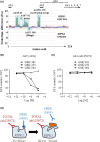Identification of an antibody-based immunoassay for measuring direct target binding of RIPK1 inhibitors in cells and tissues
- PMID: 29226625
- PMCID: PMC5723705
- DOI: 10.1002/prp2.377
Identification of an antibody-based immunoassay for measuring direct target binding of RIPK1 inhibitors in cells and tissues
Abstract
Therapies that suppress RIPK1 kinase activity are emerging as promising therapeutic agents for the treatment of multiple inflammatory disorders. The ability to directly measure drug binding of a RIPK1 inhibitor to its target is critical for providing insight into pharmacokinetics, pharmacodynamics, safety and clinical efficacy, especially for a first-in-class small-molecule inhibitor where the mechanism has yet to be explored. Here, we report a novel method for measuring drug binding to RIPK1 protein in cells and tissues. This TEAR1 (Target Engagement Assessment for RIPK1) assay is a pair of immunoassays developed on the principle of competition, whereby a first molecule (ie, drug) prevents the binding of a second molecule (ie, antibody) to the target protein. Using the TEAR1 assay, we have validated the direct binding of specific RIPK1 inhibitors in cells, blood and tissues following treatment with benzoxazepinone (BOAz) RIPK1 inhibitors. The TEAR1 assay is a valuable tool for facilitating the clinical development of the lead RIPK1 clinical candidate compound, GSK2982772, as a first-in-class RIPK1 inhibitor for the treatment of inflammatory disease.
Keywords: Benzoxazepinone; RIPK1; TEAR1; TNF; pharmacokinetics/pharmacodynamics; tissue target engagement.
© 2017 The Authors. Pharmacology Research & Perspectives published by John Wiley & Sons Ltd, British Pharmacological Society and American Society for Pharmacology and Experimental Therapeutics.
Figures




References
-
- Bonnet MC, Preukschat D, Welz PS, et al. The adaptor protein FADD protects epidermal keratinocytes from necroptosis in vivo and prevents skin inflammation. Immunity. 2011;35:572‐582. - PubMed
MeSH terms
Substances
LinkOut - more resources
Full Text Sources
Other Literature Sources
Miscellaneous

